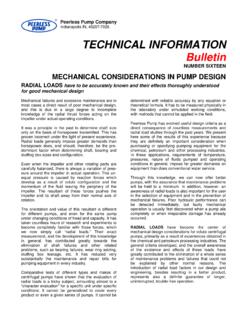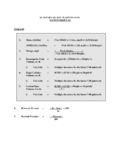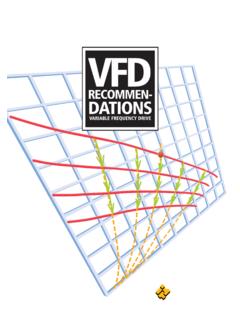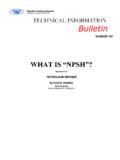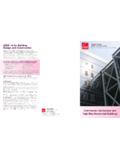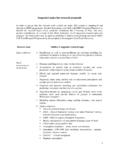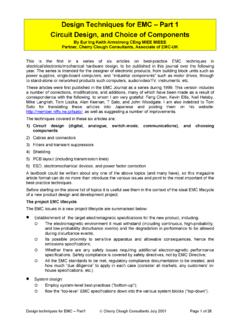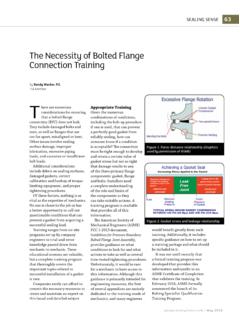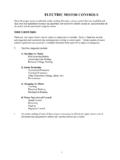Transcription of Design recommendations - gsengr.com
1 Design recommendationsfor pump stations with large centrifugal wastewater pumpsGeneral considerations for sump designDesign capacitySump dimensionsRequired sump volumeInstallation tips for submerged pumpsInstallation tips for dry installed submersible pumpsSuction pipe designInstallation guidelines for the pump and its pipingImportance of duty point and problems with off-duty pumpsITT Flygt Systems Engineering336888891010 This brochure is intended to assist application engineers, designers, planners and users of sewage and stormwater systems incorporating submerged and dry installed Flygt submersible proper Design of the pump sump in such installations is crucial. Two important Design objectives are; preventing significant quantities of air from reaching the impeller, and disposal of settled and floating solids.
2 The Flygt standard pump sump can be used as it is, or with appropriate variations to meet the requirements of most and sump are parts of an overall system that also includes a variety of structures and other elements such as ventilation systems and other handling equipment. Operating costs can be reduced with the help of effective planning and suitable operation schedules. ITT Flygt personnel and publications are available to offer guidance in these areas. Transient analysis such as air chamber dimensioning, valve selection, etc. should also be considered in wastewater pump station Design . These matters are not addressed in this brochure, but ITT Flygt can offer advice on these consult with an ITT Flygt engineer to achieve optimum pumping performance, maximum pump life, and a guarantee that product warranties are met.
3 The Design recommendations are only valid for Flygt equipment. ITT Flygt assumes no liability for non-Flygt considerations for sump Design Ideally, the flow of water into any pump should be uniform, steady, and free from swirl and entrained of uniformity can cause the impeller to operate away from the optimum Design condition, and therefore at a lower hydraulic efficiency. Unsteady flow causes the load on the impeller to fluctuate, which can lead to noise, vibration and bearing in the pump intake can cause a significant change in the operating conditions for a pump, and can produce changes in the flow capacity, power requirements and efficiency. It can also result in local vortex-type pressure reductions that induce air cores extending into the pump. This, and any other air ingestion can cause reductions in pump flow and fluctuations of impeller load which result in noise and vibration with consequent physical damage.
4 Additionally, these fluctuations can impact process loads in other parts of the system. The Design of a sump should not only provide for proper approach flow to the pumps, it should also prevent the accumulation of sediment and surface scum in the sump. The following points must be considered: Flow of water from the sump entrance should be directed toward the pump inlets in such a way that the flow reaches the inlets with a minimum of swirl. In order to prevent the formation of air-entraining surface vortices in the sump, the walls must be designed and built to avoid stagnation regions in the flow. A properly placed wall close to the inlet can reduce the tendency toward localized swirl and vorticity. The water depth also must be great enough to suppress surface vortices. Although excessive turbulence or large eddies should be avoided, some turbulence does help to prevent the formation and growth of vortices.
5 Sediment, which could be foul, must not accumulate within the sump. Stagnant regions, or regions of such low velocity where sedimentation might occur must be avoided. A sloping floor and fillets or benching often help to prevent sedimentation. For large variations in flow, part of the sump can be dedicated to low inflows with a lower floor level and a small pump. Consult ITT Flygt for an optimum sump Design . Surface scum, floating sludge and small debris can accumulate in any relatively calm region of the water surface; and this material must be pumped away. The water level should be lowered as much as possible at intervals to increase both velocity and turbulence. However, air should not be drawn into the pump. Please consult with an ITT Flygt engineer in order to achieve optimum pumping performance.
6 The occasional increases in flow velocity will also assist in preventing the accumulation of sediment on the floor. Station inflow often approaches the wet well at a relatively high elevation. In such cases, the liquid may fall a significant distance as it enters the sump. Such a drop can also occur whenever the pumps have lowered the liquid level in the sump to the point at which all pumps are about to be switched off. Therefore, the path between the sump entrance and the pump inlets must be sufficiently long for the air to rise to the surface and escape before reaching the pumps. The energy of the falling water should be dissipated sufficiently so that excessively high and irregular velocities do not occur within the sump. This can be accomplished with properly designed and placed baffle walls.
7 The sump should be as small and as simple as feasible to minimize construction costs. However, required sump volume may be specified for other reasons, such as to provide for a minimum retention time, or to ensure that only a certain number of pump starts per hour to be adopted in the Design of any sump are given in a number of Design guides or codes of practice for example, both the American Hydraulic Institute and the British Hydromechanics Research Association have published such guides. Nevertheless, whenever a new Design departs significantly from established configurations, model tests of the sump and its approaches should be capacityA sump designed in accordance with this brochure is smaller than a conventional sump. Consequently, there may be less buffer volume to accommodate transient variations of the flow rate.
8 Nor is there extra retention volume to store the inflow in excess of the total pump capacity (the pipe volumes are usually much larger than any pump station volume). A proper Design of a complete pump station should therefore consider all critical aspects of installed pump capacity must match the extreme inflows to minimize the risk of flooding. Often flow characteristics of the feeding sewer system should also be analyzed. If possible, a weir can be installed in the main sewer just upstream of the pump station in order to minimize the short-term variation of the control system for the pumps must also provide protec-tion in the event of a power failure. Precise level sensors are crucial if the sump volume is minimized in accordance with the recommendations in the preceding discharge pipe work should be designed to prevent flooding by the return flow when the pumps are stopped - also in emergency situations.
9 The effects of possible pressure surges should be minimized by appropriate Design of the control Flygt standard sumpA specially designed baffle wall minimizes air entrainment due to falling water. The flow from the inlet pipe strikes the partition wall then flows down into the inlet chamber through the slot in the floor of the baffle. The slot distributes the flow evenly toward all the pump inlets. The partition wall is high enough to ensure that the flow does not surge over it. Although the flow in the inlet chamber is highly turbulent, various materials can collect there. In such cases, side overflow weirs or side gaps may be used to carry away debris and thus prevent its accumulation. (The top of the partition wall, or parts of it should be below the highest start-level of any of the pumps to allow transport of the floating material into the pump chamber).
10 Equipping the sump with fillets, baffles, and/or benching is often beneficial depending on the number of pumps and their size. Therefore, please consult with ITT Flygt for an optimum sump avoid pre-swirl into the pump chamber, the inlet pipe must have a straight length of five pipe diameters upstream from the central front high-level entry is the sump Design is referred to as Type A1. In this configuration, the flow does not have to make a horizontal turn, which might induce mass rotation in the sump. The exact sump Design varies with the number of pumps and pump size. If the piping system and the sump location do not allow for a front entry inlet - a side entry inlet with a baffle wall modified with ports can be used. This configuration is referred to as Type A2. In this Design , the baffle wall redirects the incoming flow and distributes the flow evenly toward the pumps through the ports.
